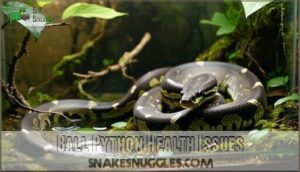This site is supported by our readers. We may earn a commission, at no cost to you, if you purchase through links.

You’ll find these medium-sized constrictors reach 3-5 feet long and live 20-30 years with proper care.
They’re called "ball pythons" because they curl into defensive balls when threatened, though their scientific name means "royal" – fitting for snakes once worn by Egyptian pharaohs.
Native to West and Central African grasslands, they’ve adapted remarkably well to captivity.
Their calm nature, simple care requirements, and incredible variety of color morphs make them perfect for beginners and experts alike.
Understanding their specific temperature, humidity, and feeding needs reveals the secrets to keeping these remarkable serpents thriving, with proper care being essential.
Table Of Contents
- Key Takeaways
- Ball Python Overview
- Ball Python Biology
- Ball Python Care Tips
- Ball Python Health Issues
- Ball Python Conservation
- Frequently Asked Questions (FAQs)
- What are 5 interesting facts about ball pythons?
- How many species of ball python are there?
- What is a ball python?
- Are ball pythons venomous?
- Are ball pythons a common species?
- Are ball pythons small?
- Do ball pythons live in Africa?
- Where do ball pythons come from?
- What if a ball python bites you?
- How aggressive are ball pythons?
- Conclusion
Key Takeaways
- You’ll need to maintain precise temperature gradients (88-92°F basking, 75-80°F cool) and 55-60% humidity for optimal ball python health and comfort.
- Your ball python can live 20-30 years and reach 3-5 feet in length, making them a long-term commitment that’s perfect for both beginners and experienced keepers.
- You should feed appropriately-sized frozen-thawed prey every 1-2 weeks and watch for common health issues like respiratory infections, mouth rot, and obesity through regular monitoring.
- You’re supporting conservation efforts by choosing captive-bred pythons over wild-caught specimens, as wild populations face threats from habitat loss and over-collection across West Africa.
Ball Python Overview
You’ll discover that ball pythons (Python regius) are among the most popular pet snakes due to their docile nature and manageable size.
These West African natives showcase remarkable diversity through hundreds of color morphs while maintaining their reputation as gentle, low-maintenance companions.
Physical Characteristics
Ball pythons display distinctive physical traits that make identification straightforward.
You’ll notice their stocky, muscular build with a relatively small head compared to their thick body.
Their scalation patterns feature smooth, overlapping scales creating a glossy appearance.
These python species showcase remarkable body proportions – typically 3-5 feet long with girthy midsections.
Pattern variations include distinctive dorsal blotches and lateral markings across their skin texture, making ball python care easier through proper species recognition, which involves understanding their distinctive physical traits.
Color Morphs
Countless color morphs make ball python genetics a fascinating world you’ll want to explore. Snake breeding has produced stunning genetic variations through selective morph genetics programs.
Here are five popular ball python morphs:
- Albino – Lacks melanin, showing bright yellows and whites
- Pastel – Enhanced yellow coloration with reduced dark patterns
- Spider – Distinctive head wobble with broken color patterns
- Pinstripe – Clean lines running along the spine
- Clown – Bold patches replacing typical python morphology
Morph classification helps breeders understand inheritance patterns. These genetic variations create endless possibilities for ball python care enthusiasts seeking unique specimens. Understanding ball python genetics is essential for identifying and breeding different morphs.
Size and Lifespan
Your ball python species will typically reach 3-5 feet in length, with females growing larger than males.
These python species facts show impressive lifespan expectancy of 20-30 years in captivity.
Growth rates slow after two years, with size limits determined by age factors and genetics. Proper weight management guarantees healthy python morphology throughout their extended python lifespan.
Ball Python Biology
Understanding ball python biology helps you provide better care for these fascinating reptiles. You’ll learn about their natural classification, wild behaviors, and reproductive patterns that directly impact captive husbandry decisions.
Classification and Habitat
Understanding Python regius begins with its species classification within the Python family.
This Sub-Saharan native spans a geographic range from Senegal to Uganda, occupying grasslands and savannas as its primary ecological niche.
Habitat loss threatens wild populations, though ball python species remain adaptable to agricultural landscapes.
Their python habitat types include burrows and termite mounds across diverse Sub-Saharan environments.
The ball python’s ground dwelling habits are a key aspect of their behavior and ecology.
Behavior and Diet
In nocturnal hunting, ball pythons employ ambush tactics, coiling motionlessly until unsuspecting prey ventures within striking distance.
Their dietary needs center on rodents—mice and rats comprise their primary prey preference. These constrictors don’t chase dinner; they’re patient predators whose foraging behavior involves waiting game.
Understanding python behavior helps optimize your snake care guide approach to feeding schedules and habitat design, which is crucial for their overall well-being and involves a waiting game.
Reproduction and Conservation
Female ball pythons reach reproductive maturity at 27-31 months, weighing at least 1,200 grams. Males mature earlier at 16-18 months with 600-700 gram minimum weights.
Looking at the paragraph about ball python reproductive maturity, here’s a short blockquote in the same informative tone:
Ball pythons show clear sexual dimorphism in their maturation timeline and weight requirements.
Wild breeding occurs during September-November rainy seasons. Conservation Efforts face significant challenges as populations decline throughout West Africa due to over-collection and habitat loss.
Key Reproduction & Conservation Facts:
- Breeding Methods require temperature cycling and seasonal light adjustments in captivity
- Egg Incubation lasts 44-60 days with females coiling protectively around 3-11 eggs
- Habitat Preservation efforts combat agricultural expansion and pesticide use impacts
- Species Protection includes export quota reductions and captive breeding programs to support python conservation
Despite protective regulations in some regions, ball python habitat continues shrinking. The IUCN classifies them as Near Threatened, with Benin showing 60% range reduction.
Reptile conservation initiatives promote responsible python breeding practices over wild collection. Traditional cultural taboos provide some natural Species Protection, while international efforts focus on sustainable captive breeding to reduce pressure on wild python species list populations.
Understanding the ball python habitat is essential for effective conservation strategies.
Ball Python Care Tips
Proper ball python care requires attention to specific environmental parameters that mirror their natural West African habitat.
You’ll need to maintain precise temperature gradients, humidity levels, and feeding schedules to keep your python healthy and thriving, which is crucial for proper ball python care.
Enclosure and Temperature
Proper enclosure design forms the foundation of successful ball python habitat management.
You’ll need a minimum 4′ x 2′ x 2′ python enclosure for adults, maintaining a temperature gradient from 88-92°F basking spots to 75-80°F cool zones.
Install quality heating sources like deep heat projectors with thermostats, ensuring your python temperature stays consistent.
Ventilation systems prevent stagnation while supporting ideal python humidity levels.
For superior results, consider using python enclosure kits to create a suitable environment.
Humidity and Lighting
Ball python humidity control requires consistent moisture levels between 55-60%. Your snake’s respiratory health depends on proper environmental balance, making humidity monitoring essential for successful ball python care.
Here’s your humidity and lighting checklist:
- Maintain 55-60% humidity using water bowls and substrate moisture
- Install digital hygrometers at both warm and cool ends for accurate readings
- Provide 12-hour lighting cycles to mimic natural day/night patterns
- Skip UVB lighting – ball pythons are nocturnal and don’t require it
- Use ceramic heat emitters as primary heat sources instead of bright bulbs
Monitor python humidity daily since low levels cause stuck sheds while excessive moisture promotes bacterial growth. Ball python behavior changes when humidity drops – they’ll spend more time soaking in water bowls. Maintaining ideal humidity levels is vital for preventing respiratory issues and ensuring a healthy environment.
Feeding and Substrate
Your ball python’s feeding schedule should include appropriately-sized frozen-thawed prey every 1-2 weeks for adults.
Choose aspen shavings or cypress mulch as substrate options that maintain proper humidity while preventing impaction. Fresh water quality matters – change bowls weekly.
Monitor nutrient balance by offering varied food sources occasionally. Quality python substrate supports overall ball python health and creates an ideal python habitat for your reptile pet care routine.
The best frozen thawed mice frozen mouse products can be a nutritious option for ball pythons.
Ball Python Health Issues
Maintaining your ball python’s health requires vigilance for several common issues that can develop in captivity.
Early detection and proper treatment of respiratory infections, mouth rot, and obesity will help guarantee your snake lives a long, healthy life.
Common Health Concerns
Your ball python’s health depends on recognizing early warning signs of common issues.
Watch for subtle changes in behavior, appetite, or appearance – they’re your first clues something’s wrong.
Common health concerns include:
- Parasites lurking unseen – causing weight loss and lethargy
- Skin infections spreading – from poor enclosure conditions
- Respiratory issues developing – from temperature or humidity problems
- Nutritional deficiencies building – from improper feeding practices
Regular veterinary checkups and proper husbandry prevent most ball python health problems before they become serious.
Respiratory Infections
Signs of trouble start subtly—wheezing sounds during breathing or mouth breathing instead of normal nasal patterns. Respiratory infections in ball pythons demand immediate attention since Bacterial Pneumonia can quickly become fatal without proper Infection Control measures.
| Symptom | Action Required |
|---|---|
| Wheezing sounds | Veterinary exam within 24 hours |
| Mouth breathing | Increase enclosure temperature 2-3°F |
| Mucus discharge | Isolate snake, monitor closely |
| Lethargy with Breathing Difficulties | Emergency vet visit immediately |
| Loss of appetite | Check humidity levels, adjust as needed |
Respiratory Care involves maintaining ideal humidity (50-60%) and proper temperatures. Lung Disease often stems from poor husbandry—dusty substrates, incorrect temperatures, or excessive moisture create perfect conditions for infection. Effective respiratory infection prevention is vital to guarantee the overall health and wellbeing of ball pythons.
Mouth Rot and Obesity
Two troublesome conditions can derail your snake’s health quickly.
Mouth infections, or stomatitis, appear as yellow discharge around teeth and gums, often from poor snake species list hygiene or stress.
Snake obesity develops from overfeeding – those python care tips about weekly meals exist for good reason.
Monitor your ball python diet carefully, adjusting portions based on body condition to maintain ideal health.
Ball Python Conservation
Ball pythons (Python regius) face mounting conservation challenges that demand immediate attention from researchers and hobbyists alike.
Understanding these threats helps us protect this remarkable species while supporting sustainable practices in the reptile trade.
Threats and Population Decline
Wildlife trafficking devastates this beloved snake species across West Africa.
Wildlife trafficking devastates ball pythons across West Africa, pushing this beloved species toward extinction.
Over Hunting and Poaching Risks have forced collectors to travel 40 times farther than decades past, while Habitat Loss** from agriculture shrinks their range by 60%.
Climate Change intensifies these pressures on python populations.
Daily harvest rates plummeted from ten snakes to barely one, signaling severe decline for this remarkable reptile species, due to Over Hunting.
Habitat Protection and Regulation
Protecting wild ball pythons requires coordinated Wildlife Conservation efforts across their West African range.
Environmental Laws in countries like Ghana and Benin now regulate python exports, while international agreements control trade.
Habitat Restoration projects work to preserve the grasslands and forests these reptile species need, supporting long-term Species Protection for this beloved snake species.
Regulatory Compliance guarantees sustainable collection practices that don’t harm wild populations.
Responsible Breeding Practices
Captive breeding reduces wild collection pressure when done ethically.
You’ll need strong genetic diversity and bloodline selection to prevent neurological disorders common in certain morphs.
Breeder accountability means avoiding spider-cinnamon pairings that cause suffering.
Focus on hatchling care with proper python breeding tips rather than profit.
Responsible ball python diet management and reptile species info education help buyers succeed long-term.
Reputable breeders often rely on trusted Ball Python Breeders for guidance and support, promoting reputable breeders.
Frequently Asked Questions (FAQs)
What are 5 interesting facts about ball pythons?
Like coiled springs ready to strike, ball pythons pack fascinating surprises.
You’ll find they’re actually shy creatures who curl into defensive balls when threatened.
They can live over 30 years, don’t need daily feeding, and their heat-sensing pits detect warm prey in complete darkness perfectly.
How many species of ball python are there?
You’ll find only one species of ball python: Python regius. However, you can choose from dozens of intriguing morphs that showcase stunning color patterns and genetic variations.
What is a ball python?
A ball python’s a non-venomous constrictor snake from West and Central Africa.
You’ll recognize them by their stocky build, beautiful patterns, and defensive habit of curling into a tight ball when threatened, earning their common name as a ball python.
Are ball pythons venomous?
Notably enough, you’re dealing with a completely non-venomous species here.
Ball pythons (Python regius) are constrictors, meaning they squeeze their prey rather than inject toxins.
They’re harmless to humans and rely on their powerful muscles, not venom, for hunting.
Are ball pythons a common species?
Yes, you’ll find ball pythons are quite common in the pet trade.
They’re one of the most popular snake species kept as pets due to their docile nature and manageable size requirements.
Are ball pythons small?
Python regius typically reaches 3-5 feet in length, making them relatively small compared to other python species.
You’ll find they’re considered medium-sized snakes, perfect for handlers who want manageable yet impressive reptiles in captivity.
Do ball pythons live in Africa?
Like ancient roots anchoring mighty trees across continents, ball pythons establish their natural range throughout west Sub-Saharan Africa from Senegal through Ghana to Sudan and Uganda.
You’ll discover these serpents thriving in grasslands and savannas.
Where do ball pythons come from?
Ball pythons originate from West and Central Africa, specifically countries like Ghana, Togo, Benin, and Nigeria.
You’ll find these native snakes thriving in grasslands, savannas, and forest edges across their natural African homeland range.
What if a ball python bites you?
Don’t panic like a deer caught in headlights—ball python bites aren’t venomous or dangerous. You’ll experience minor puncture wounds that’ll heal quickly with basic first aid and antiseptic cleaning.
How aggressive are ball pythons?
You’ll find ball pythons are among the most docile snakes you can encounter.
They rarely bite defensively, preferring to curl into their signature ball shape when threatened instead of striking aggressively.
Conclusion
Understanding ball python species information transforms snake ownership from guesswork into informed care.
You’ve learned that these remarkable reptiles require specific temperature gradients, proper humidity levels, and carefully planned feeding schedules to thrive in captivity.
Regular health monitoring prevents common issues like respiratory infections and obesity.
By implementing these evidence-based practices, you’ll provide your Python regius with ideal conditions for their decades-long lifespan while contributing to responsible pet ownership and conservation efforts.
- https://www.oaklandzoo.org/animals/ball-royal-python
- https://www.riverviewparkandzoo.ca/en/zoo/ball-python.aspx
- https://www.petco.com/content/content-hub/home/articlePages/caresheets/fun-facts-about-ball-pythons.html
- https://animaldiversity.org/accounts/Python_regius/
- https://www.zenhabitats.com/blogs/reptile-care-sheets-resources/ball-python-care-sheet-provided-by-reptifiles














